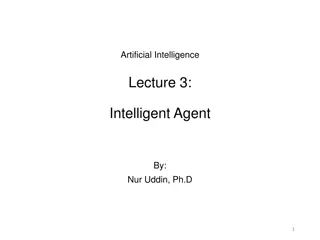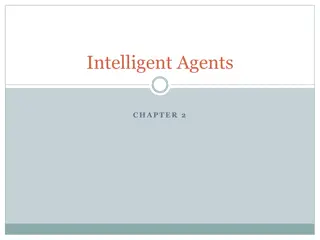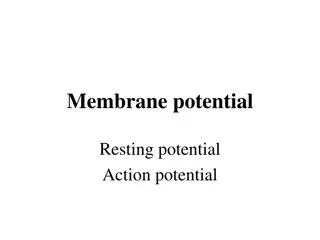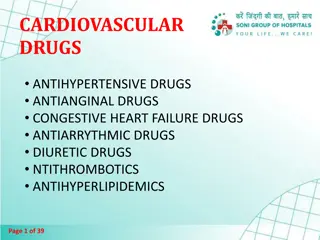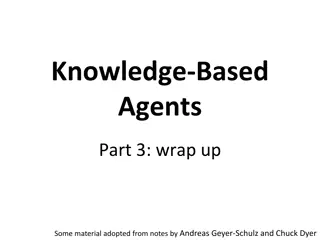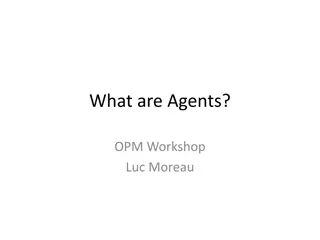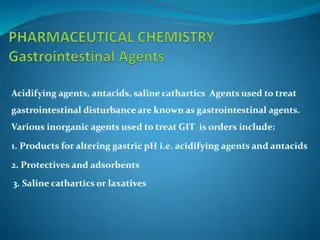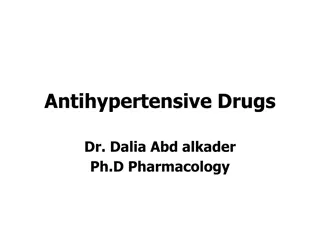Overview of Antihypertensive Agents and their Mechanisms of Action
Explore the classification of antihypertensive agents used in treating hypertension, including beta blockers, centrally acting agents, ganglionic blockers, ACE inhibitors, vasodilators, and more. Learn about the Renin-Angiotensin System, ACE inhibitors, and specific drugs like Captopril and Benazepril, their properties, mechanisms of action, uses, doses, and preparations. Gain insights into how these medications work to lower blood pressure, reduce oxygen demand on the heart, and manage conditions like heart failure, left ventricular dysfunction, and diabetic nephropathy.
Download Presentation

Please find below an Image/Link to download the presentation.
The content on the website is provided AS IS for your information and personal use only. It may not be sold, licensed, or shared on other websites without obtaining consent from the author.If you encounter any issues during the download, it is possible that the publisher has removed the file from their server.
You are allowed to download the files provided on this website for personal or commercial use, subject to the condition that they are used lawfully. All files are the property of their respective owners.
The content on the website is provided AS IS for your information and personal use only. It may not be sold, licensed, or shared on other websites without obtaining consent from the author.
E N D
Presentation Transcript
ANTIHYPERTENSIVE AGENTS Drugs used in the treatment of Hypertension. (The normal BP range is 120-=80MM Hg) Classification of Official Drugs = 15 Beta blockers: Timolol Centrally acting: Methyl Dopa, clonidine catecholamine depletors: Reserpine Ganglionic blockers: Guanethidine; Quanabenz acetate, ACEI: Captopril, Lisinopril, Enalapril, Quinapril benazepril, Vasodilators: Sodium nitroprusside, Minoxidil, Hydralazine Hcl, Diazoxide
ACEI: Angiotensin-Converting-Enzyme Inhibitors ACEIs are a class of Drugs used primarily for the treatment of High Blood Pressure and Heart Failure. They work by causing relaxation of blood vessels as well as a decrease in blood volume, which leads to lower blood pressure and decreased oxygen demand from the Heart Official ACEI & their mechanism 1.Benazepril 2.Captopril, 3. Enalapril 4. Lisinopril, 5. Quinapril, NOTE: RENIN INHIBITORS: Aliskiren, Enalkiren, Remkiren AT2 ANTAGONISTS: Alisartan, Irbisartan, losartan, Telmisartan BRADYKININ: an active peptide of kinin, that causes inflammation and potent vasodilator, mild diuretic
CAPTOPRIL (Capotan) CATEGORY: Antihypertensive(ACEI) NOMENCLATURE: 1-[(2s)-3-mercapto-2-methylpropionyl]- L-Proline PROPERTIES : White to off-white, crystalline powder; odour characteristic, sulphide like. It is freely soluble in water; methanol, ethanol and in chloroform. It should be kept in airtight container. MP: Melts between 104-1100 MOA: It is Captopril is the prototype-first orally active ACE Inhibitor. It act by competitively inhibit angiotensin-I (an inactive decapeptide) in to angiotensin-II (an active octa-peptide) by binding to angiotensin converting enzyme (ACE). It s Oral bioavailability is 60-75%, (to be taken 1 Hr. before meal due to food interference the absorption of drug) USES: Used in hypertension, heart failure, left ventricular dysfunction and diabetic nephropathy DOSE: Orally, 25-150 mg bid or tid PREPARATIONS: Captopril tablets (12.5, 25, 50 and 100 mg)
BENAZEPRIL Hcl (Lotensin) CATEGORY: Antihypertensive agent NOMENCLATURE: 3-[[1-(ethoxycarbonyl)-3-phenylprpyl]- amino]-tetrahydro-2-oxo-1H-1-Benzaepine-1-acetic acid PROPERTIES :White crystalline powder; soluble in water, ethanol, methanol. MOA: An ACE Inhibitor. A prodrug rapidly absorbed and converted to active drug benazeprilat USES: Benazepril is used to treat hypertension , CHF DOSE: Orally, 80 mg daily/Max PREPARATIONS: Benazepril Hcl 5 mg, 10 mg, 20 mg, 40 mg tablets
ENALAPRIL (Vasotec) CATEGORY: Antihypertensive agent NOMENCLATURE: It is a (2S)-1-[(2S)-2-[(1S)-1-(ethoxycarbonyl)-3- phenylpropyl)amino]- propanyl]-pyrrolidine-2-carboxylic acid-(Z)- butanedioate PROPERTIES :white crystalline powder, sparingly soluble in water. stored, protected from light MOA: An ACE Inhibitor. Enolapril (Prodrug) owes its activity to Enalaprilat(Drug) to which it is converted after biotransformation. ITS ORAL BA: 60% USES Asymptomatic left ventricular dysfunction (LVF), heart failure DOSE: Orally, 5-20 mg/day (40 mg maximum) PREPARATIONS: ENALAPRIL maleate 2.5 mg, 5 mg, 10 mg, 20 mg Tablets IP; 1 mg/ml Oral Solution
LISINOPRIL (Prinivil; Zestril) CATEGORY: Antihypertensive agent NOMENCLATURE: It is 2S-1-[(2S)-6-amino-2-[[(1s)-1-Carboxy-3- phenylpropyl]amino]hexonyl-pyrrolidine-2-carboxylic acid dehydrate PROPERTIES: It is a white crystalline powder, soluble in water, stored protected from moisture temperature not exceeding 25 degree C MOA: An ACE Inhibitor. It is a lysine analog of Enalaprilate (unlike enalapril it is already an active diacid), and has slowly, incompletely absorbed orally (30% only) USES: Lisinopril is used to treat of Hypertension, Heart failure , acute myocardial infarction and in Diabetic nephropathy DOSE: Orally, 10 mg-20mg /day PREPARATIONS: Lisinopril 5 mg, 10 mg, 20 mg, 40 mg tablets IP, BP
QUINAPRIL (Accupril) CATEGORY: Antihypertensive agent NOMENCLATURE: It is white crystals PROPERTIES : 2-[2-[[1-ethoxy carbonyl)-3-phenyl propyl]amino]-1-oxopropyl-tetrahydro-3-isoquinoline carboxylic acid MOA: An ACE Inhibitor; a prodrug readily absorbed and rabidly hydrolyzed to active form Quinaprilat USES: Quinapril is used to treat congestive heart failure (CHF) and hypertension DOSE: Orally, 40 mg/day PREPARATIONS: Quinapril 5 mg, 10 mg, 20 mg, 40 mg tablets






